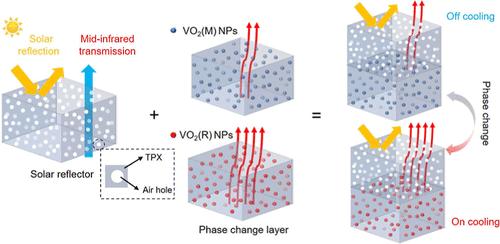基于光谱解耦的双层聚合物/VO2 NP纳米复合材料自适应辐射冷却研究
IF 8.2
2区 材料科学
Q1 MATERIALS SCIENCE, MULTIDISCIPLINARY
引用次数: 0
摘要
低能耗和环境可持续性的必要性加强了对无电输入的被动辐射冷却系统的需求。然而,在低温下固有的冷却效应极大地阻碍了它们的节能潜力。此外,传统设计的不灵活性限制了它们在复杂或非平面表面的应用。为了克服这些挑战,我们提出了一种柔性智能辐射冷却器(FSRC),它协同集成了太阳反射层(聚4-甲基戊烯,TPX)和相变层(VO2 NPs@TPX)。这种新颖的结构使FSRC具有光谱自适应的反射率和发射能力以及对温度波动的动态响应。模拟结果表明,FSRC具有显著的能量管理能力,其特点是最小的太阳吸收率(0.13)和高红外发射率可调性(0.37)。室外现场试验和建筑能耗模拟进一步验证了FSRC的实际可行性和有效性。这项工作不仅为实现辐射冷却提供了一种光谱解耦策略,而且还提出了一种有前途的器件架构和替代技术解决方案,使从静态光热管理向动态光热管理演变。本文章由计算机程序翻译,如有差异,请以英文原文为准。

Adaptive Radiative Cooling via Spectral Decoupling in Bilayered Polymer/VO2 NP Nanocomposites
The imperatives of low energy consumption and environmental sustainability have intensified the demand for passive radiative cooling systems that operate without electrical input. However, the inherent cooling effect under low temperatures significantly hampers their energy-saving potential. Besides, the inflexibility of conventional designs restricts their application to complex or nonplanar surfaces. To surmount these challenges, we propose a flexible smart radiative cooler (FSRC) that synergistically integrates a solar reflective layer (poly-4-methylpentene, TPX) with a phase-change layer (VO2 NPs@TPX). This novel architecture empowers the FSRC with spectrally self-adaptive reflectance and emission capabilities and dynamic response to temperature fluctuations. Simulation results highlight the FSRC’s remarkable energy management capabilities, characterized by minimal solar absorptance (0.13) and high infrared emissivity tunability (0.37). Outdoor field tests and building energy consumption simulations further validate the practical feasibility and efficacy of FSRC. This work not only offers a spectral decoupling strategy for realizing radiative cooling but also presents a promising device architecture and alternative technological solution that enables the evolution from static to dynamic photothermal management.
求助全文
通过发布文献求助,成功后即可免费获取论文全文。
去求助
来源期刊

ACS Applied Materials & Interfaces
工程技术-材料科学:综合
CiteScore
16.00
自引率
6.30%
发文量
4978
审稿时长
1.8 months
期刊介绍:
ACS Applied Materials & Interfaces is a leading interdisciplinary journal that brings together chemists, engineers, physicists, and biologists to explore the development and utilization of newly-discovered materials and interfacial processes for specific applications. Our journal has experienced remarkable growth since its establishment in 2009, both in terms of the number of articles published and the impact of the research showcased. We are proud to foster a truly global community, with the majority of published articles originating from outside the United States, reflecting the rapid growth of applied research worldwide.
 求助内容:
求助内容: 应助结果提醒方式:
应助结果提醒方式:


